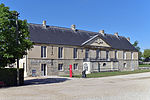Grand Accélérateur National d'Ions Lourds
French Alternative Energies and Atomic Energy CommissionFrench National Centre for Scientific ResearchInstitutes associated with CERNLaboratories in FranceNuclear research institutes ... and 1 more
Research institutes in France
The Grand Accélérateur National d'Ions Lourds (GANIL), or Large Heavy Ion National Accelerator, is a French national nuclear physics research center in Caen. The facility has been in operation since 1983, and consists primarily of two serialised synchrocyclotrons. It is a part of the French Alternative Energies and Atomic Energy Commission (CEA), more specifically the CEA Paris-Saclay center.
Excerpt from the Wikipedia article Grand Accélérateur National d'Ions Lourds (License: CC BY-SA 3.0, Authors).Grand Accélérateur National d'Ions Lourds
Boulevard Henri Becquerel, Caen
Geographical coordinates (GPS) Address Nearby Places Show on map
Geographical coordinates (GPS)
| Latitude | Longitude |
|---|---|
| N 49.214444444444 ° | E -0.36055555555556 ° |
Address
Campus Jules Horowitz
Boulevard Henri Becquerel
14000 Caen
Normandy, France
Open on Google Maps





